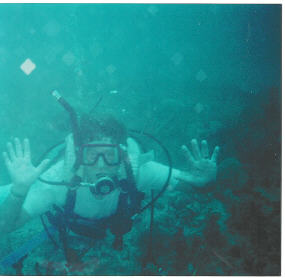Martinique - July 18, 1984
H.M.S. Diamond Rock is 600 feet high. It looks like the top half of a large green granite cabbage off the Martinique coast. The rock was once occupied by the British who hauled cannons to the top. Admiral Hood commissioned it as a sloop in an impressive display of non-linear thinking. Strangely, the small island is still registered by the Admiralty as a British warship. The French defeated the British forces by floating a wreck with a number of barrels of rum up to the rock. They then proceeded to liberate the island fortress in a bloodless victory 12 hours later.My wife and son went there with me for diving. They both passed on the big trip to the rock. Our modern American gear didn't mate up with the French air tanks so I had to use their primitive equipment with no depth gauges, compasses or spare regulators.
In spite of my American Divemaster certification, I had to learn and demonstrate French diving hand signals to be permitted to sign up for the dive. They told us that we would be going into a beautiful cavern. One rule they had that was "special" was that it was not permitted to surface if we ran out of air. Instead, we were required to swim to the group leader who had extra regulators and two tanks and ask him for permission to breathe his spare air.
We departed to dive the H.M.S. Diamond Rock on an old Chris Craft. A young Frenchman was the Captain. He lived on the boat with his wife and his baby.
The Diamond Rock cavern is shaped like an acute triangle with the apex only about 15 degrees, the floor is about ten feet across and the walls generally are about 30-40 feet high. Prolific sea fans and corals make the cavern itself beautiful and interesting.
A cavern is generally defined in the diving world as an enclosed space where you can always see at least a little daylight no matter how far in you go. A cave, by contrast, allows a diver to go deep enough to encounter complete darkness on sunny days with good water visibility conditions. There is a cavern in Florida, spring-fed, where you can go in 300 feet, turn off your flashlight and still see the entrance glow. I don't do caves and have no interest in becoming cave-qualified.
Cave divers are a strange bunch. They lay down line to find their way out, carry three lights and are trained to begin their exits after using 1/3 of their air. In spite of that a number of divers drown in Florida caves every year...one young man took his last minutes to scratch "love you mom and dad" on his tanks...what a waste.
I get a little antsy even in caverns because you can't just go straight up in an emergency swimming ascent when things go wrong.
The cavern was very spectacular. It was formed when a huge slab of granite rock fell down millions of years ago (or at least a while back). The cavern walls were covered with beautiful corals and sea fans. The current blew us in quite smartly for about 75 yards. Then we turned around. Progress back was very difficult and slow because of the apparently unanticipated strong current blowing into the cavern. I pulled myself hand-by-hand along the floor of the cavern because it was impossible to make progress swimming. This hard work and the strong current caused me to nearly deplete my air supply before emerging....my entire dive party left me behind in a frenzy of panicky swimming activity and they all ran out of air in the cavern and then attached themselves to the "dive leader" who had two tanks. Because I pulled myself along the floor, in addition, to gently kicking, I emerged later with precious little air to spare and nowhere to go but up. It was my favorite dive out of the maybe 1500 I've done.
When I came out of the cavern and could again see the blue sky overhead, the two other divers with me had both run out of air in the cavern and were breathing off the group leader's two regulators. The group leader was actually breathing from his buoyancy control exhaust hose (a trick I never learned in my advanced courses). I swam over and showed him that I only had 200 pounds of air left and made the proper American signal (the bye-bye fluttery wave) for "I'm getting the hell out of here, you idiot!". I swam slowly to the surface to avoid embolisms without asking for any further permission, in complete violation of the dive rules.
On the way back, the young French Captain blew what appeared to be about two bottles of fine red French wine in the most perfect display of projectile vomiting I have ever seen. A colorful end to a perfect dive.

